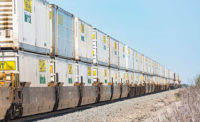Unleashing the potential of temperature-controlled logistics in the meat and poultry sector
The cold chain comprises various components, each of which is critical in preserving the products.

All parties involved in moving temperature-sensitive product—shippers, carriers, vendors, providers, etc.—need to understand the importance of maintaining a cold chain.
Have you ever considered the journey that a steak or chicken filet takes before it arrives on your plate? Surprisingly, most people overlook this process. However, whether you're enjoying a meal at your favorite restaurant or shopping for groceries at your local supermarket, there is an intricate transportation process that ensures the smooth movement of food from farm to fork.
Without these critical temperature-controlled logistics solutions, moving fresh and frozen products across the globe wouldn't be possible.
What is a cold chain?
A cold chain is a method of preserving and prolonging the shelf life of perishable goods like food, medicine, and other items. It involves storing and distributing these products within specific temperature ranges to ensure their quality and safety.
The cold chain starts from the point of production, where the goods are packaged under controlled conditions and extends to storage facilities and transportation systems that deliver the products to the end consumer. All these stages are meticulously monitored and regulated for temperature to avoid any compromise in the product's quality or potency.
The cold chain is fundamental in preserving perishable goods like meat, dairy products, fruits, vegetables and vaccines. It is vital to uphold precise temperature levels to prevent spoilage, ensuring the safety of these products for consumption or use.
How does a cold chain work?
A cold chain comprises various components, each of which is critical in preserving the products. Below is a step-by-step breakdown of how it functions, particularly in the meat and poultry sector:
- Harvesting and initial processing: Once animals are slaughtered for meat, the products are immediately chilled or frozen to a safe temperature to inhibit bacterial growth. This initial stage is critical as it sets the standard for the rest of the cold chain.
- Packaging: The meat is then packaged to maintain its temperature during transit. Often, this involves insulated packaging materials and refrigerants like gel packs or dry ice.
- Storage: The packaged meat is stored in refrigerated warehouses or cold storage facilities. These facilities are designed to maintain an optimal temperature and humidity level to preserve the quality of the product.
- Distribution: The products are transported to retailers using refrigerated trucks or cargo containers. These vehicles have temperature control systems to keep the products at the required temperature throughout the journey.
- Retail: Upon reaching the retail outlets, the products are immediately moved to refrigerated display units until customers purchase them.
Innovations and technologies shaping temperature-controlled logistics
Several exciting innovations and technologies shape the future of temperature-controlled logistics in the meat and poultry sector. These advancements enhance efficiency, improve transparency, and ensure product safety throughout the cold chain.
Advanced refrigeration systems
Modern refrigeration systems have come far from their predecessors. Today's systems are designed with energy efficiency and environmental impact in mind. They utilize advanced compressors and eco-friendly refrigerants to minimize energy consumption and greenhouse gas emissions.
Additionally, they often incorporate smart technologies that allow real-time monitoring and control of temperature settings, ensuring optimal conditions are always maintained.
IoT and real-time monitoring
The Internet of Things (IoT) is revolutionizing the cold chain by enabling real-time monitoring of product temperatures. IoT sensors placed within packaging or transport vehicles continually collect and transmit data on temperature conditions.
This information can be analyzed instantly, allowing immediate action if temperatures deviate from the optimal range, preserving product quality and safety.
Blockchain technology for traceability and transparency
The use of blockchain technology improves the security and transparency of tracking the cold chain process. Every action or change in status is recorded and added to a chain of information that cannot be tampered with. This advanced technology enables easier identification of the source of any problems and offers consumers a clearer understanding of their food's journey.
Robotics and automation in cold storage facilities
Robotics and automation are increasingly used in cold storage facilities to enhance efficiency and accuracy. Robots can perform tasks such as sorting, packing, and moving products, reducing human error and increasing productivity.
Automated systems can also manage inventory and monitor temperature conditions, ensuring products are stored correctly and safely.
Sustainable packaging solutions
Sustainable packaging solutions are becoming more prevalent in temperature-controlled logistics. These include biodegradable materials, recyclable packaging, and packaging designed to maintain optimal temperatures with minimal energy consumption.
These solutions reduce environmental impact and improve product quality by ensuring optimal conditions are maintained throughout the cold chain.
Benefiting from the efficiency of cold chain transportation
The cold chain is vital in the meat and poultry industry as it ensures temperature-controlled logistics at every stage, from production to distribution. With supply chains growing more complex, the demand for temperature-controlled transportation becomes crucial.
With the right innovations and technologies, this sector can leverage the efficiency of cold chain transportation to ensure product safety and quality while minimizing environmental impact.
Looking for a reprint of this article?
From high-res PDFs to custom plaques, order your copy today!









